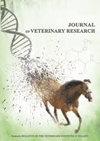The efficiency of mycotoxin binding by sorbents in the in vitro model using a naturally contaminated animal feed
IF 1.3
3区 农林科学
Q2 VETERINARY SCIENCES
引用次数: 0
Abstract
The productivity of domestic animals and the safety of food products derived from them are jeopardised by mycotoxins in animal feed. To control them, feed additives are used, which limit the absorption of mycotoxins in the gastrointestinal tract of animals by binding to them. The study aimed to evaluate the effectiveness of a new in vitro model in experiments on the binding of mycotoxins from buffers and contaminated feed and to confirm the effect of a single sorbent or mixture in binding them. Nine mineral sorbents were tested for their efficiency binding eight mycotoxins. Two in vitro experiments were conducted to indicate the mycotoxin-binding capacity of sorbents, each specifying a buffer with one of two different pH levels reflecting gastrointestinal conditions (pH 3.5 and 7.0). The first investigated the sorbent with only the buffer and mycotoxin standards, while the second did so with the sorbent, buffer and feed naturally contaminated with mycotoxins (deoxynivalenol, zearalenone, and ochratoxin A). The sorption was significantly lower in the trial with feed. In the first experiment at gastric pH (pH 3.5), activated charcoal bound deoxynivalenol and sepiolite bound zearalenone at 70% and 96%, respectively, whereas in the second experiment with feed, the binding was only 3% and 6%. The study underlines the challenge of finding a feed additive that would work comprehensively, binding all mycotoxins regulated by law.在使用天然污染动物饲料的体外模型中,吸附剂吸附霉菌毒素的效率
动物饲料中的霉菌毒素危及家畜的生产率和食品的安全。为了控制霉菌毒素,人们使用饲料添加剂,通过与霉菌毒素结合来限制动物胃肠道对霉菌毒素的吸收。这项研究旨在评估一种新的体外模型在缓冲液和受污染饲料中霉菌毒素结合实验中的有效性,并确认单一吸附剂或混合物在结合霉菌毒素方面的效果。 对九种矿物吸附剂结合八种霉菌毒素的效率进行了测试。为显示吸附剂的霉菌毒素结合能力,进行了两次体外实验,每次实验都指定了两种不同 pH 值(pH 值为 3.5 和 7.0)的缓冲液,以反映胃肠道条件。第一项研究只使用缓冲液和霉菌毒素标准物质对吸附剂进行吸附,第二项研究则使用吸附剂、缓冲液和受霉菌毒素(脱氧雪腐镰刀菌烯醇、玉米赤霉烯酮和赭曲霉毒素 A)自然污染的饲料进行吸附。 在使用饲料的试验中,吸附率明显较低。在胃 pH 值为 3.5 的第一次实验中,活性炭对脱氧雪腐镰刀菌烯醇和玉米赤霉烯酮的吸附率分别为 70% 和 96%,而在用饲料进行的第二次实验中,吸附率仅为 3% 和 6%。 这项研究强调了寻找一种能全面发挥作用的饲料添加剂的挑战性,这种添加剂能结合法律规定的所有霉菌毒素。
本文章由计算机程序翻译,如有差异,请以英文原文为准。
求助全文
约1分钟内获得全文
求助全文
来源期刊

Journal of Veterinary Research
Veterinary-General Veterinary
CiteScore
0.90
自引率
5.60%
发文量
58
审稿时长
18 weeks
期刊介绍:
Journal of Veterinary Research (formerly Bulletin of the Veterinary Institute in Pulawy) is a quarterly that publishes original papers, review articles and short communications on bacteriology, virology, parasitology, immunology, molecular biology, pathology, toxicology, pharmacology, and biochemistry. The main emphasis is, however, on infectious diseases of animals, food safety and public health, and clinical sciences.
 求助内容:
求助内容: 应助结果提醒方式:
应助结果提醒方式:


